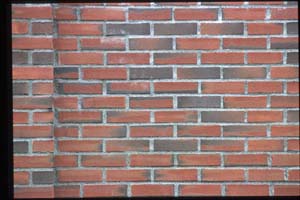 |
Entire frame: MF (At f/5.6) |
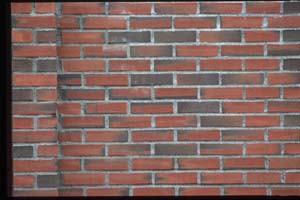 |
Entire frame: AFS (At f/5.6) |
Good Vibrations Turning Bad - The Sad
Case of AFS 300 mm f/4 Nikkor
(and a happy ending?)
By Bjørn Rørslett
I had eagerly awaited my review sample of the AFS 300 mm f/4 ED-IF Nikkor for some time now. This lens would replace the old AF version with its outdated AF system, and give Nikon users an "economy" alternative to the professional AFS long-focal Nikkors. However, during lens testing I encountered problems with this new lens that should not go unnoticed for others.
Basically, the AFS 300 mm f/4 Nikkor is a well-built, fairly compact medium telephoto design and nice workmanship, although by necessity it is somewhat fatter along the waist than its AF predecessor. However, filter thread size is slimmed from 82 mm to 77 mm to conform with most of the newer "pro" Nikkors. The lens shade is telescoping but can - at last - be screwed into a locked position (same principle as the 400 mm f/3.5 nikkor). The focusing collar is moved further back to allow easy manual focusing, something that was nearly impossible on the AF 300/4. There is an M/A switch similar to that of other AFS lenses allowing easy and precise manual tuning of focus at any time, even when the lens is driven by the AFS system to a sharply focused setting. So far, so good.
Most people would, sometimes or even permanently, deploy their 300 mm lenses on tripods. So would I. However, the tripod collar on the AFS 300 mm f/4 is a textbook example of bad design. Probably in order to save a few yen, the designers opted for a very narrow collar, which rides on a soft dampening material. The tripod mount extends from the collar in a cantilevered fashion and is outrageously thin, and flexes easily. I had serious thoughts about the usefulness of this tripod attachment. Subsequent test shooting proved me, unfortunately, more than correct in my suspicion.
For the images shown here, both lenses were set to f/5.6 and exposures were identical at 1/15 sec. I used Provia 100 F in my Nikon F5 for the test shooting of brick walls (I must have at least a national record in brick wall photography) and all frames for both lenses were adjacent on the test roll. I examined and scored the processed film using my standard setup with a Nikon stereomicroscope at 40X magnification and halogen fibre-optical lighting. For illustrative purposes, I just publish two shots which show what the fuss is all about. The frames are scanned at 2700 dpi (16X oversampling) in a Nikon LS-2000 film scanner, with no exposure adjustment so the frames and details therein can be directly compared.
 |
Entire frame: MF (At f/5.6) |
 |
Entire frame: AFS (At f/5.6) |
There is a small difference in colour rendition between these 300 mm lenses, with the older MF lens being slighly warmer, and the AFS 300 having subtly higher colour saturation. The difference is visible in side-by-side test shots, clearly indicated here, but I sincerely doubt the practical siginificance of this.
The details below represent an area of 3 by 4 mm in the centre of the test images. The images speak for themselves. While the image obtained with the MF 300 lens displays all the crispness and sharpness you would expect from a professional lens - even individual sand grains in the brick mortar are clearly visible, the AFS Nikkor turned in a disasterous result. No more and no less. Upon scrutinising this image, you can easily see tell-tale signs of vibrational movement. There is a blurred streaking slanted to the left showing the whole setup did shake violently while the frame was exposed. In fact, the viewfinder image with the AFS 300 mounted had that "swimming" quality about it that I personally associate with the cheapest of cheap tripods.
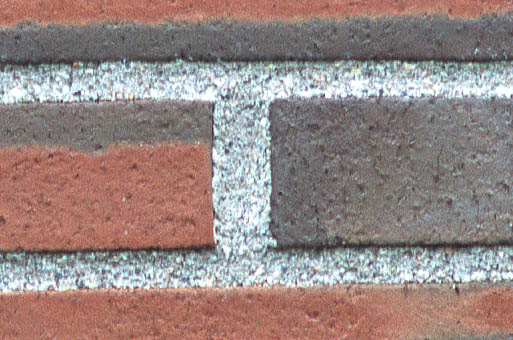 |
MF Nikkor 300 mm f/2.8 f/5.6, 1/15 sec. Impeccable image clarity and crisp details. |
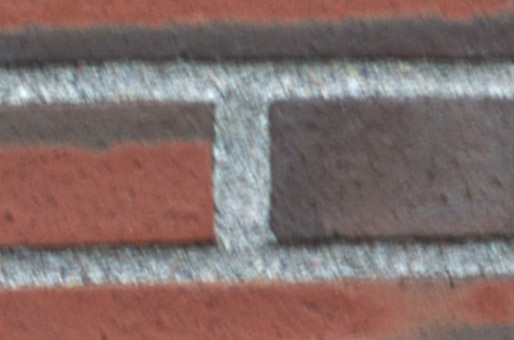 |
AFS Nikkor 300 mm f/4 f/5.6, 1/15 sec. The less said the better ... Note clear streaking in the blur pattern, caused by motion blur. |
Now, it could possibly be claimed that my setup wasn't fair and biased in the disfavour of the AFS Nikkor lens, firstly because a heavy professional camera (F5, made even heavier with its attached "L" bracket) was employed. Secondly, I used a very light and extremely rigid tripod, my Sachtler S-14 (now designated DA-75) equipped with the substantial Foba Studioball head. Since this setup is slightly less expensive (in Norway, at least) than the 300 Nikkor, it might be argued it was of insufficient quality to keep the lens and F5 steady. However, as evidenced by the concurrently taken test shots with the MF 300 Nikkor, the Sachtler tripod enabled that very lens to deliver images of the highest quality calibre, so why not with the AFS 300?
Admittedly, test exposures ranged from 1/60 to 1/2 sec and thus were squarely within the "danger" zone for camera-induced vibrations. However, why should this only be a problem with the AFS 300, and not apply to all other tested lenses? The answer is quite simply that none of the other lenses had this poorly designed tripod collar, and thus mounted securely on my tripod. Just take a look at the tripod collars of, say, a manual 300 or 400 mm Nikkor, and feel their massive solidity. These tripod collars do their task perfectly.
In fact, I have shot test sequences with all of my long Nikkors on this very Sachtler tripod, and they include the 300 mm f/4 and f/4.5 Nikkors which never gave any problems at all. Coming to think of it, this would be the first jarred pictures caused by a poor tripod collar amongst the more than 100.000 shots taken on my Sacthler tripods.
For some later test shots done with the D1, and using a heavy-duty Sachtler fluid-head on my tripod, much sharper images were obtained with the 300 AFS. Of course, at shutter speeds faster than 1/125 sec with a tripod-mounted lens you would expect sharp results and the AFS lens delivered the goods, this time. I was able to confirm the lack of colour fringing in these images, so essentially proving the potential high quality of the optics of the AFS 300 lens. What a pity this quality is so well hidden....
The really sad thing about the whole affair is that the forthcoming AF-VR 80-400 Nikkor has an identically designed tripod collar. Good grief. I won't say more - some people never learn, but possibly the VR technology needs a vibration-prone lens to work its magic? Time will tell.
Added note: Since this review first was published, I've been deluged with mails claiming I didn't perform the tests correctly, thus the end result should be blamed on me, my poor tripod and my inadequate testing setup. In response to this I can only repeat that no other lens tested under similar conditions did produce such bad results. Draw your own conclusions.
And by the way, I now have received independent owner's statements to the effect that their experiences with the AFS 300/4 confirm my findings. This lens indeed is extremely prone to unsteadiness when mounted on a tripod, of any kind in fact.
Recently, I learnt from a review published on a not-so-critical website that the gripe about poor tripod support was BULL (literal quotation), and that sharp images were obtained at 2 second exposures. That statment doesn't prove a thing because all vibrations would dissipate at such long exposures anyway. Please note my observations refer to using exposures in the difficult range 1/2 to 1/60 sec.
Final note 1 (6 Dec, 2000): I just learned today that Nikon has made an update of the tripod collar. The external look is quite similar, but the collar and in particular the cantilevered portion now make a much more solid impression, and the flexing is nearly vanished. Seems they have enforced a critical segment just below the locking screw, plus added a thicker and tighter inner felt clothing to the ring riding on the lens barrel. I examined several samples of this 300 and the 80-400 VR as well, and all had the new and improved collar. I will in due time re-test the AFS 300/4 to convince myself that Nikon finally got their act together.
***
Final note 2 (15 Dec, 2000): Today I had opportunity of examining the two collars side by side. I did this on two 80-400 VR Nikkors with sn. 2025xx (old) and 2034xx (new), respectively. Externally they look virtually identical. However, when you rap them with the knuckles, the old version has a resonating "brittle" sound to it, whilst the new version sounds "dull". There are subtle differences in the cast too and they fit the lens barrel differently, the newer version being a much tighter fit. Presumably the material in the casting has been changed and this has lead to the increased rigidity of the collar. However, I still think the design basically is flawed and should be replaced by a much better collar. The optics deserve it and so do the buyers.
***
THE Final Note (20 January, 2001): Lots of people complain to me about the problems with AFS 300/4 - as if I should be held responsible for this predicament? However, I for one am always looking for solutions to any problem - be it small or big - so here are two alternatives that in fact work.
 |
This
is no joke: It works |
| The perfect solution for asthmatic photographers (I'm one of them). Use an asthma inhaling canister in its plastic casing, and wedge it firmly into position as shown above. This is guaranteed to stabilise the lens perfectly, and you have your medication freely available, too. Total cost should be $0. | |
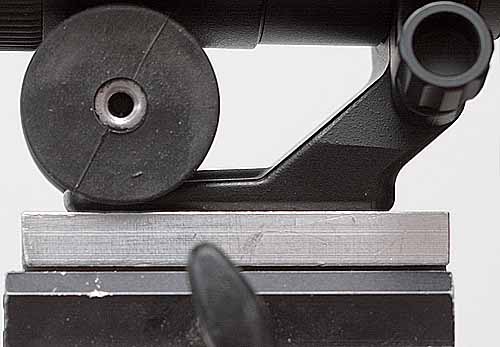 |
|
| For the gadget-conscious photographer, there is a handy rubber-grip thingy from Manfrotto/Bogen which also works quite well. This item is intended for use on a monopod and costs less than $10. |